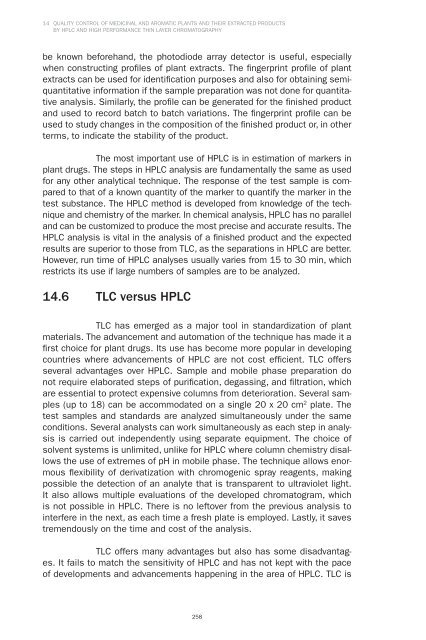Extraction Technologies for Medicinal and Aromatic ... - Capacity4Dev
Extraction Technologies for Medicinal and Aromatic ... - Capacity4Dev
Extraction Technologies for Medicinal and Aromatic ... - Capacity4Dev
Create successful ePaper yourself
Turn your PDF publications into a flip-book with our unique Google optimized e-Paper software.
14 QUALITY CONTROL OF MEDICINAL AND AROMATIC PLANTS AND THEIR EXTRACTED PRODUCTS<br />
BY HPLC AND HIGH PERFORMANCE THIN LAYER CHROMATOGRAPHY<br />
be known be<strong>for</strong>eh<strong>and</strong>, the photodiode array detector is useful, especially<br />
when constructing profi les of plant extracts. The fi ngerprint profi le of plant<br />
extracts can be used <strong>for</strong> identifi cation purposes <strong>and</strong> also <strong>for</strong> obtaining semiquantitative<br />
in<strong>for</strong>mation if the sample preparation was not done <strong>for</strong> quantitative<br />
analysis. Similarly, the profi le can be generated <strong>for</strong> the fi nished product<br />
<strong>and</strong> used to record batch to batch variations. The fi ngerprint profi le can be<br />
used to study changes in the composition of the fi nished product or, in other<br />
terms, to indicate the stability of the product.<br />
The most important use of HPLC is in estimation of markers in<br />
plant drugs. The steps in HPLC analysis are fundamentally the same as used<br />
<strong>for</strong> any other analytical technique. The response of the test sample is compared<br />
to that of a known quantity of the marker to quantify the marker in the<br />
test substance. The HPLC method is developed from knowledge of the technique<br />
<strong>and</strong> chemistry of the marker. In chemical analysis, HPLC has no parallel<br />
<strong>and</strong> can be customized to produce the most precise <strong>and</strong> accurate results. The<br />
HPLC analysis is vital in the analysis of a finished product <strong>and</strong> the expected<br />
results are superior to those from TLC, as the separations in HPLC are better.<br />
However, run time of HPLC analyses usually varies from 15 to 30 min, which<br />
restricts its use if large numbers of samples are to be analyzed.<br />
14.6 TLC versus HPLC<br />
TLC has emerged as a major tool in st<strong>and</strong>ardization of plant<br />
materials. The advancement <strong>and</strong> automation of the technique has made it a<br />
fi rst choice <strong>for</strong> plant drugs. Its use has become more popular in developing<br />
countries where advancements of HPLC are not cost effi cient. TLC offers<br />
several advantages over HPLC. Sample <strong>and</strong> mobile phase preparation do<br />
not require elaborated steps of purifi cation, degassing, <strong>and</strong> fi ltration, which<br />
are essential to protect expensive columns from deterioration. Several samples<br />
(up to 18) can be accommodated on a single 20 x 20 cm 2 plate. The<br />
test samples <strong>and</strong> st<strong>and</strong>ards are analyzed simultaneously under the same<br />
conditions. Several analysts can work simultaneously as each step in analysis<br />
is carried out independently using separate equipment. The choice of<br />
solvent systems is unlimited, unlike <strong>for</strong> HPLC where column chemistry disallows<br />
the use of extremes of pH in mobile phase. The technique allows enormous<br />
fl exibility of derivatization with chromogenic spray reagents, making<br />
possible the detection of an analyte that is transparent to ultraviolet light.<br />
It also allows multiple evaluations of the developed chromatogram, which<br />
is not possible in HPLC. There is no leftover from the previous analysis to<br />
interfere in the next, as each time a fresh plate is employed. Lastly, it saves<br />
tremendously on the time <strong>and</strong> cost of the analysis.<br />
TLC offers many advantages but also has some disadvantages.<br />
It fails to match the sensitivity of HPLC <strong>and</strong> has not kept with the pace<br />
of developments <strong>and</strong> advancements happening in the area of HPLC. TLC is<br />
258

















